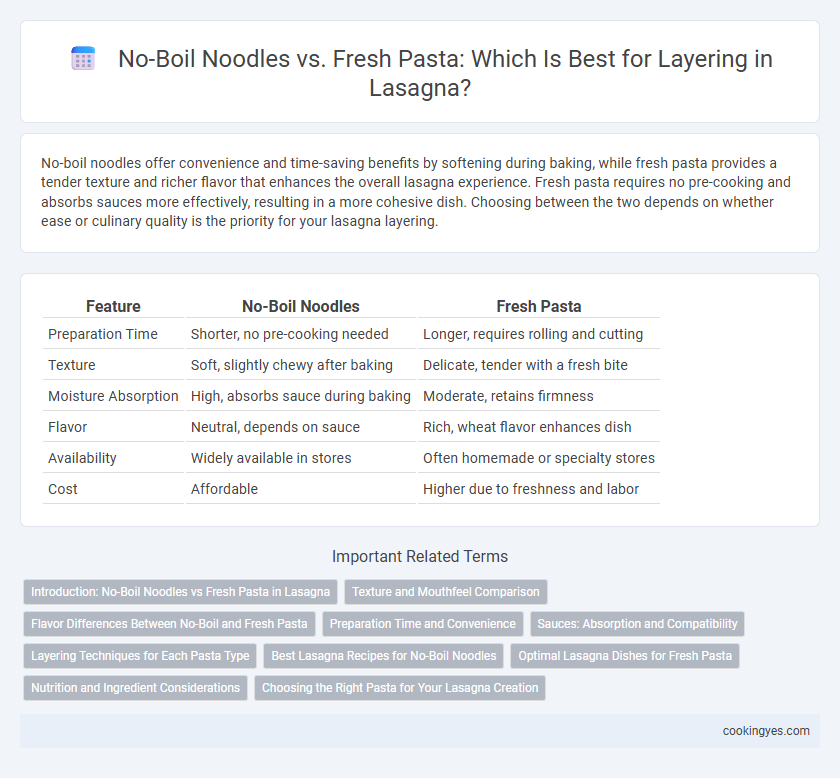No-boil noodles offer convenience and time-saving benefits by softening during baking, while fresh pasta provides a tender texture and richer flavor that enhances the overall lasagna experience. Fresh pasta requires no pre-cooking and absorbs sauces more effectively, resulting in a more cohesive dish. Choosing between the two depends on whether ease or culinary quality is the priority for your lasagna layering.
Table of Comparison
| Feature | No-Boil Noodles | Fresh Pasta |
|---|---|---|
| Preparation Time | Shorter, no pre-cooking needed | Longer, requires rolling and cutting |
| Texture | Soft, slightly chewy after baking | Delicate, tender with a fresh bite |
| Moisture Absorption | High, absorbs sauce during baking | Moderate, retains firmness |
| Flavor | Neutral, depends on sauce | Rich, wheat flavor enhances dish |
| Availability | Widely available in stores | Often homemade or specialty stores |
| Cost | Affordable | Higher due to freshness and labor |
Introduction: No-Boil Noodles vs Fresh Pasta in Lasagna
No-boil noodles offer convenience and time-saving benefits by softening directly in the sauce during baking, while fresh pasta provides a tender texture and rich flavor that enhances the overall lasagna experience. No-boil noodles typically contain precooked semolina and are ideal for quick preparation without compromising layering integrity. Fresh pasta, made from eggs and flour, requires less cooking time before assembling but delivers a more delicate bite and authentic Italian taste.
Texture and Mouthfeel Comparison
No-boil noodles provide a firmer texture that gradually softens during baking, offering a consistent bite that holds up well in multilayered lasagna. Fresh pasta contributes a delicate, tender mouthfeel with a silkier finish, enhancing the overall richness but requiring careful cooking to avoid sogginess. Texture contrast between the resilient no-boil noodles and the softer fresh pasta defines the lasagna's structural and sensory experience.
Flavor Differences Between No-Boil and Fresh Pasta
No-boil noodles absorb sauce during baking, resulting in a denser texture and a milder wheat flavor. Fresh pasta offers a tender bite and a richer, egg-infused taste that enhances the overall lasagna experience. The choice between no-boil and fresh pasta significantly impacts the flavor complexity and mouthfeel of the final dish.
Preparation Time and Convenience
No-boil noodles significantly reduce preparation time by eliminating the need for pre-cooking, making them a convenient option for quick lasagna assembly. Fresh pasta requires minimal cooking but demands extra effort in rolling and cutting, which can extend the preparation process. Choosing no-boil noodles maximizes convenience without compromising the texture of the layered dish.
Sauces: Absorption and Compatibility
No-boil noodles are engineered to absorb sauce during baking, swelling and integrating flavors for a cohesive texture. Fresh pasta offers a tender bite and requires less sauce absorption, preserving the distinct taste of rich sauces like bechamel or ragu. Choosing between these pasta types affects sauce compatibility, with no-boil noodles favoring thicker, more liquid sauces, while fresh pasta pairs well with both light and dense sauces for optimal layering.
Layering Techniques for Each Pasta Type
No-boil noodles require careful layering with sufficient sauce to ensure proper hydration and even cooking, preventing dryness or uneven texture in the lasagna. Fresh pasta layers benefit from lighter sauce application, as their higher moisture content allows for quicker absorption, which helps maintain delicate texture and prevents sogginess. Mastering layering techniques tailored to each pasta type enhances the final dish's consistency and taste, delivering a perfect balance between pasta firmness and sauce richness.
Best Lasagna Recipes for No-Boil Noodles
No-boil noodles simplify lasagna preparation by absorbing sauce directly during baking, eliminating the need for pre-cooking while maintaining tender layers. Best lasagna recipes using no-boil noodles recommend a rich, well-seasoned sauce with ample moisture to ensure even cooking and prevent dryness. Fresh pasta offers a delicate texture but requires precise timing, whereas no-boil noodles provide convenience without compromising flavor or structure in layered lasagna dishes.
Optimal Lasagna Dishes for Fresh Pasta
Fresh pasta offers a tender texture and delicate flavor that elevates lasagna dishes, absorbing sauces more effectively than no-boil noodles. Its pliability allows for thinner, more uniform layers, resulting in a harmonious balance of pasta, cheese, and filling in every bite. Optimal lasagna dishes with fresh pasta benefit from shorter cooking times, preserving the pasta's freshness and enhancing the overall dish quality.
Nutrition and Ingredient Considerations
No-boil noodles typically contain added starches and preservatives to maintain texture and shelf stability, which can slightly increase carbohydrate content compared to fresh pasta made from simple flour and eggs. Fresh pasta offers a cleaner ingredient profile with higher protein quality and fewer additives, promoting better nutrient absorption for layering in lasagna. Choosing fresh pasta supports a more natural texture and flavor while ensuring lower sodium levels than processed no-boil alternatives.
Choosing the Right Pasta for Your Lasagna Creation
No-boil noodles offer convenience with their ability to absorb sauce during baking, ensuring a moist and tender lasagna without pre-cooking. Fresh pasta provides a delicate texture and rich flavor, enhancing the overall dish but requires careful handling and precise layering to prevent sogginess. Selecting between no-boil noodles and fresh pasta depends on your priority for time-saving convenience or authentic texture and taste in your lasagna creation.
No-boil noodles vs Fresh pasta for layering Infographic

 cookingyes.com
cookingyes.com